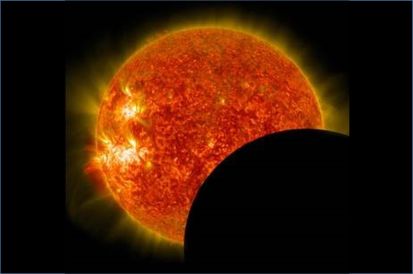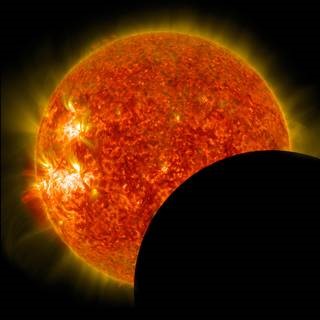
Recommended safety tips for viewing Aug. 21 solar eclipse

For the first time in 99 years, a total solar eclipse will occur across the entire continental United States; and NASA is preparing to share this experience of a lifetime on August 21. Viewers around the world will be provided a wealth of images captured before, during, and after the eclipse by 11 spacecraft, at least three NASA aircraft, more than 50 high-altitude balloons, and the astronauts aboard the International Space Station – each offering a unique vantage point for the celestial event.
NASA Television will air a multi-hour show, “Eclipse Across America: Through the Eyes of NASA,” with unprecedented live video of the celestial event, along with coverage of activities in parks, libraries, stadiums, festivals and museums across the nation, and on social media.
From Oregon to South Carolina, 14 states will – over a span of almost two hours – experience more than two minutes of darkness in the middle of the day. When the moon completely blocks the sun, day will turn into night and make visible the otherwise hidden solar corona, the sun’s atmosphere. Bright stars and planets also will become visible. Using specialized solar viewing glasses or other equipment, all of North America will be able to view at least a partial eclipse lasting two to four hours.
“Never before will a celestial event be viewed by so many and explored from so many vantage points – from space, from the air, and from the ground,” said Thomas Zurbuchen, associate administrator of NASA’s Science Mission Directorate in Washington. “With our fellow agencies and a host of scientific organizations, NASA will continue to amplify one key message: Take time to experience the Aug. 21 eclipse, but experience it safely.”
The only safe way to look directly at the uneclipsed or partially eclipsed sun is through special-purpose solar filters, such as eclipse glasses or handheld solar viewers. Homemade filters or ordinary sunglasses, even very dark ones, are not safe for looking at the sun. In the 70-mile-wide swath of the country that will experience a total eclipse, it’s safe to look at the total eclipse with your naked eyes only during the brief period of totality, which will last about two minutes, depending on your location.
It’s common sense not to stare directly at the Sun with your naked eyes or risk damaging your vision, and that advice holds true for a partially eclipsed Sun. Note that only with special-purpose solar filters, such as eclipse glasses or a handheld solar viewer, can you safely look directly at the Sun.
NASA recommends that people who plan to view the eclipse should check the safety authenticity of viewing glasses to ensure they meet basic proper safety viewing standards.
Eclipse viewing glasses and handheld solar viewers should meet all the following criteria:
- Have certification information with a designated ISO 12312-2 international standard;
- Have the manufacturer’s name and address printed somewhere on the product;
- Not be used if they are older than three years, or have scratched or wrinkled lenses;
- Not use homemade filters, or be substituted for ordinary sunglasses — not even very dark ones — because they are not safe for looking directly at the Sun.
According to our favorite American space agency:
“While NASA isn’t trying to be the eclipse safety glasses ‘police,’ it’s our duty to inform the public about safe ways to view what should be a spectacular sky show for the entire continental United States,” said Alex Young, associate director for science in the Heliophysics Science Division at NASA’s Goddard Space Flight Center in Greenbelt, Maryland. “It’s important that individuals take the responsibility to check they have the proper solar eclipse viewing glasses. With the eclipse a month away today, it’s prudent to practice ahead of time.”
An alternative method for safe viewing of the partially-eclipsed Sun is with a pinhole projector. With this method, sunlight streams through a small hole – such as a pencil hole in a piece of paper, or even the space between your fingers – onto a makeshift screen, such as a piece of paper or the ground. It’s important to only watch the screen, not the Sun. Never look at the Sun through the pinhole – it is not safe.
NASA has coordinated with medical and science professionals to provide additional safety information. For details, visit:
https://eclipse2017.nasa.gov/safety
More than 6,800 libraries across the U.S. are distributing safety-certified glasses. Many are working with scientists to hold viewing events and activities before and during the eclipse. For a listing of participating libraries, visit:
https://www.starnetlibraries.org/2017eclipse
NASA Television is offering a special live program, “Eclipse Across America: Through the Eyes of NASA” with real-time coverage of the event from coast to coast. The nearly four-hour program will include unprecedented images of the Aug. 21 eclipse from numerous spacecraft — including the International Space Station – high-altitude aircraft and balloons, and ground observations. Each will offer a unique vantage point for the eclipse. Additionally, the broadcast will include live coverage of activities in parks, libraries, stadiums, festivals and museums across the nation, and on social media.
- For more information on viewing safety, visit: https://eclipse2017.nasa.gov/safety
- To watch the Aug. 21 NASA TV eclipse broadcast online and access interactive web content and views of the eclipse from more than 60 telescopes, aircraft and balloons, visit: https://www.nasa.gov/eclipselive
Source: NASA / Written by: Ace News Today Staff






